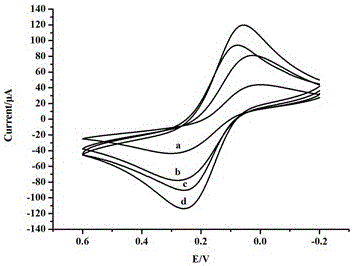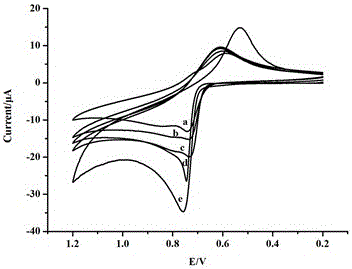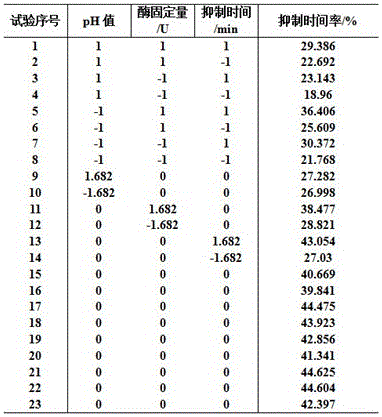Preparation and application of nano cerium oxide/mesoporous carbon sensor for detecting pesticide
A technology of nano-cerium oxide and mesoporous carbon, which is applied in the direction of instruments, measuring devices, scientific instruments, etc., can solve the problems of inapplicable on-site detection, time-consuming, and endangering human life
- Summary
- Abstract
- Description
- Claims
- Application Information
AI Technical Summary
Problems solved by technology
Method used
Image
Examples
Embodiment 1
[0039] Example 1 Preparation and application of a sensor for detecting pesticides based on nano-cerium oxide / mesoporous carbon
[0040] 1) Preparation of nano-cerium oxide-chitosan composites and ordered mesoporous carbon-chitosan composites: weigh 0.5 g chitosan in a beaker, add 1.0% acetic acid solution and stir to dissolve, dissolve well The solution was placed in a 250 mL volumetric flask and constant volume, the solution after constant volume was poured into a beaker, and magnetically stirred under a magnetic stirrer for 10 h to obtain a 0.2% chitosan solution; take 4 mg of nano-cerium oxide and disperse it in In 4 mL of 0.2% chitosan solution, sonicate in an ultrasonic cleaner until uniformly dispersed to obtain a 1 mg / mL nano-cerium oxide-chitosan composite; take 2 mg of ordered mesoporous carbon and dissolve in 4 ml of 0.2 % chitosan solution, in an ultrasonic cleaner for 1 hour to obtain a uniform, black suspension, which is 0.5 mg / mL ordered mesoporous carbon-chitosa...
Embodiment 2
[0044] Example 2 Electrochemical characterization during electrode assembly
[0045] figure 1 Shown are the cyclic voltammetry curves of different electrodes in a phosphate buffer solution containing 0.1 mol / L KCl and 5 mmol / L potassium ferricyanide. Curve (a) in the figure is a characterization diagram of an empty screen-printed electrode, We can see the obvious redox peak; as shown in the curve (b) in the figure, when the screen printing electrode is decorated with cerium oxide-chitosan nanomaterials, the current increases significantly; as shown in the curve (d) After modifying the ordered mesoporous carbon-chitosan material on this basis, the current increased significantly because the ordered mesoporous carbon also had good conductivity; when 5 μL of 0.02 U of acetylcholinesterase was immobilized, Since the enzyme is a macromolecular protein, it not only does not conduct electricity, but also hinders the electron transfer at the interface, so the peak value of the curren...
Embodiment 3
[0047] Example 3 Optimization of test conditions
[0048] Three test conditions of acetylcholinesterase biosensor The pH value of the test bottom solution, the amount of acetylcholinesterase immobilized, and the incubation time were optimized through the quadratic rotation orthogonal test, and the best test conditions were obtained: pH value 8.0, acetylcholinesterase immobilized amount 0.1 U, incubation time 12 min; prepare phosphate buffers with pH values of 7.0, 7.4, 8.0, 8.6, and 9.0, and use these phosphate buffers to prepare a series of pH values of 1.0 mmol / L thiochloride Acetylcholine base solution, the fixed amount of acetylcholinesterase was 0.06 U, 0.076 U, 0.1 U, 0.124 U, 0.14 U; the pesticide inhibition time was controlled as 8 min, 9.6 min, 12 min, 14.4 min, 16 min, according to the designed According to the test plan, the current value was detected, and the optimal test conditions were selected: pH value 8.0, acetylcholinesterase immobilization amount 0.1 U, ...
PUM
 Login to View More
Login to View More Abstract
Description
Claims
Application Information
 Login to View More
Login to View More - R&D
- Intellectual Property
- Life Sciences
- Materials
- Tech Scout
- Unparalleled Data Quality
- Higher Quality Content
- 60% Fewer Hallucinations
Browse by: Latest US Patents, China's latest patents, Technical Efficacy Thesaurus, Application Domain, Technology Topic, Popular Technical Reports.
© 2025 PatSnap. All rights reserved.Legal|Privacy policy|Modern Slavery Act Transparency Statement|Sitemap|About US| Contact US: help@patsnap.com



